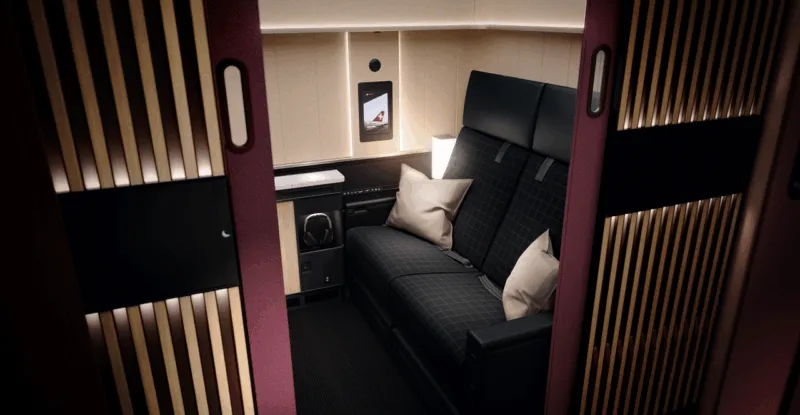Please enjoy this Op-Ed contribution from Ellie Parkes, International Sales Manager at Replin by Hainsworth
In today’s competitive airline industry, passengers have increasingly high expectations. While much attention is given to service, punctuality, and digital touchpoints, one element quietly yet powerfully shapes the overall passenger experience: textiles. The fabrics that surround passengers, from the seat they sit on to the blankets and bedding they use, are not just functional; they are a tangible expression of an airline’s brand.
For me, textiles are critical to shaping the passenger journey. They touch every sense, subtly influencing how passengers feel throughout their flight. The sense of space, the quality of light, and the textures that passengers encounter all play a role in creating an impression of comfort and quality. Yet, I often see textiles being treated as an afterthought. Airlines tend to focus on meals, service, or the digital experience, but the cabin fabrics affect passengers on a more subconscious level.
Textiles contribute to more than just comfort; they help tell the airline’s brand story. Flying through the sky in a metal tube is an inherently unusual experience, and fabrics provide a sense of familiarity and homeliness. They can evoke a connection to home, a luxury hotel, or the destination itself, helping passengers feel more at ease. The right materials can express quality, attention to detail, and the values an airline wants to communicate.
For example, in the SWISS Senses suite, we used our woven Eclipse fabrics on vertical surfaces such as walls and doors. The linen-look textures and northern European aesthetic were designed to reflect the SWISS brand’s commitment to quality and meticulous craftsmanship, demonstrating how bespoke textiles can transform a cabin into an environment that is both visually cohesive and emotionally resonant.
Over the years, I’ve seen a significant shift in how airlines approach cabin textiles. Where bedding was once the primary touchpoint, we now integrate fabrics into seats, suites, bulkheads, and other cabin elements. This approach extends the airline’s design language across the entire passenger journey, from lounges to digital touchpoints, creating a more seamless brand experience. Luxury is no longer defined solely by newness; it is defined by sensory engagement and bespoke design. Textures, colour, and the tactile quality of materials become a powerful language for communicating an airline’s identity and values.
Collaboration is essential in bringing these brand visions to life. At Replin by Hainsworth, we take a holistic approach, combining our technical expertise in textile construction with the creative vision of airline design studios. Innovation comes from exploring new fibres and textures, drawing inspiration not just from aviation, but from other industries that we operate in, including fashion, interior design, and even protective fabrics used by firefighters. Recent projects such as our Tundra and Cocoon fabric collections exemplify this, harnessing the beauty of natural and undyed fibres to create fabrics that are luxurious, durable, and sustainable.
Sustainability has become a central consideration in every project. Airlines increasingly expect their fabrics to be responsibly sourced and long-lasting, but this must never compromise design quality or performance. Our approach balances natural fibres with carefully engineered synthetics, ensuring compliance with aviation safety standards while creating fabrics that remain beautiful and functional for years. Longevity is central to sustainability: the longer a fabric remains in use, the lower its environmental impact. Being part of initiatives such as the Green Cabin Alliance allows us to stay connected with industry peers and customers to continually advance sustainable practices.
Textiles also play a critical role in influencing passenger perception and loyalty. People react to materials the way they do in their homes or in what they choose to wear. The fabrics we experience onboard affect our sense of comfort and quality, often in subtle ways that shape overall brand preference.
In a market where differentiation is increasingly challenging, textiles are a tangible way to reinforce an airline’s identity and create meaningful connections with passengers. Airlines are starting to recognise this, treating fabrics not as an optional “cherry on top,” but as a strategic differentiator that is integral to cabin design. Early involvement of colour, material, and finish (CMF) designers ensures that the choices of textiles align with broader design strategies and enhance the emotional impact of the cabin.
Looking ahead, I see textiles playing an even more dynamic role in elevating the passenger journey. Emerging opportunities include fabrics that interact with onboard systems, further integrating comfort, brand identity, and technology. Passenger expectations are also evolving, and travellers increasingly expect the comfort, design, and service they enjoy on the ground, coupled with a strong commitment to sustainability. Airlines that can anticipate these expectations and embed them into their cabin materials and design will create lasting competitive advantage.
Ultimately, textiles are far more than a functional element of the cabin. They are the silent ambassadors of a brand, shaping passenger perception, enhancing comfort, and communicating values without a word being spoken. By combining bespoke design, technical performance, and sustainable innovation, airlines can transform the tactile environment of the cabin into a powerful driver of brand loyalty and passenger satisfaction.
For airlines seeking to differentiate their brand through materials and design, the key is foresight and integration. Textiles are as fundamental to the passenger experience as the mechanics of the seat itself. Bringing design teams on board early in the process ensures that every fabric choice contributes to the overarching brand story. When executed thoughtfully, textiles elevate the passenger journey in ways that are both felt and remembered, making them a vital component of modern aviation.
 About the author
About the author
Ellie Parkes has over 16 years of experience in global account management and strategic business development. She studied Textile Design at university and has since worked in design, marketing and sales across interior design, high-street supply and tailoring.
She worked at John Horsfall, a supplier of premium airline blankets and amenities, for over a decade where she held the role of Global Business Development Manager, responsible for leading the global sales team, exploring new product developments and expanding the international customer base.
Parkes has been a visible presence in the aviation industry, both as a panel speaker and a regular contributor to the airline industry press. With extensive industry experience, she brings creativity, commercial acumen and real-life textiles expertise to the procurement process.
Featured image credited to SWISS












